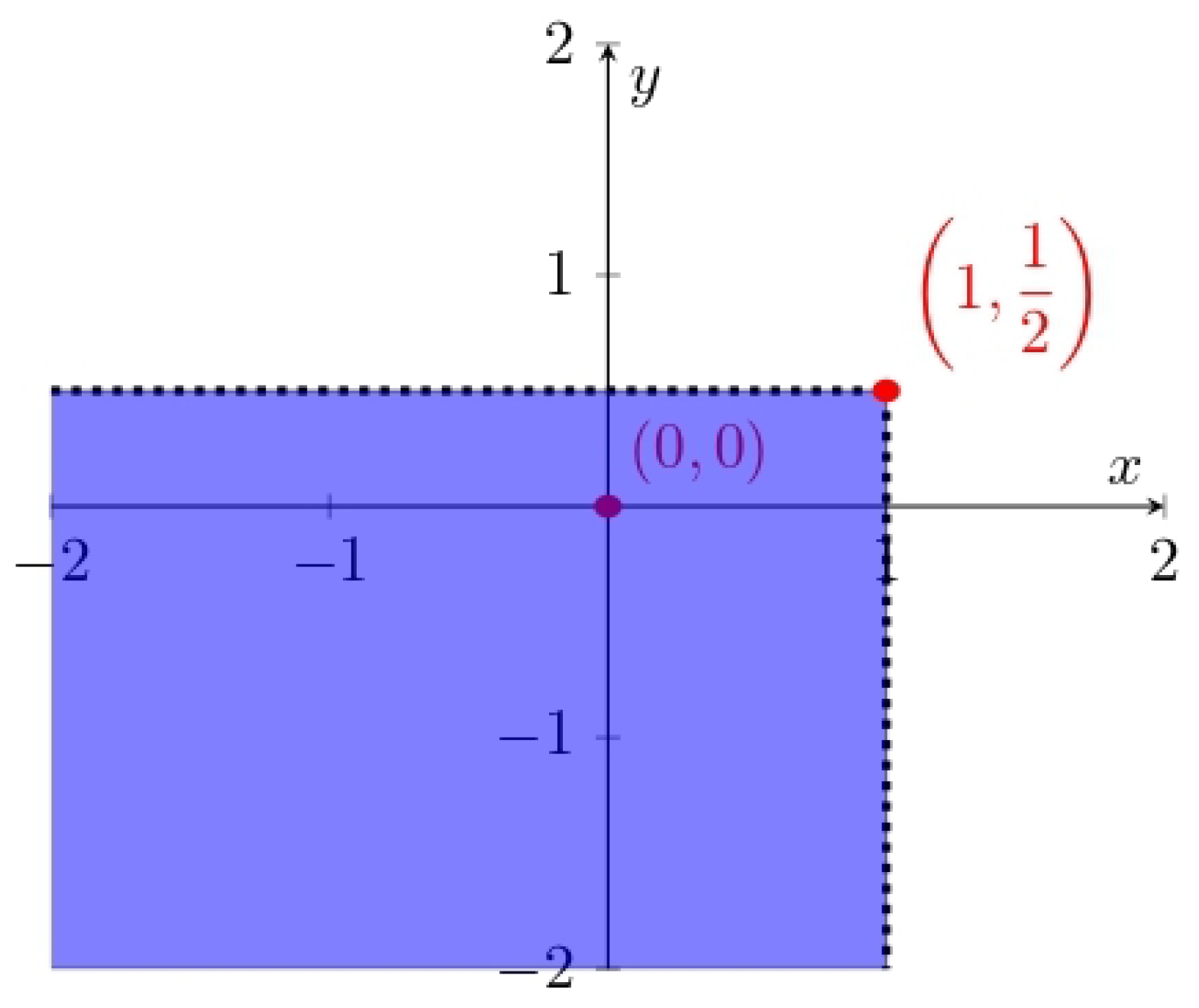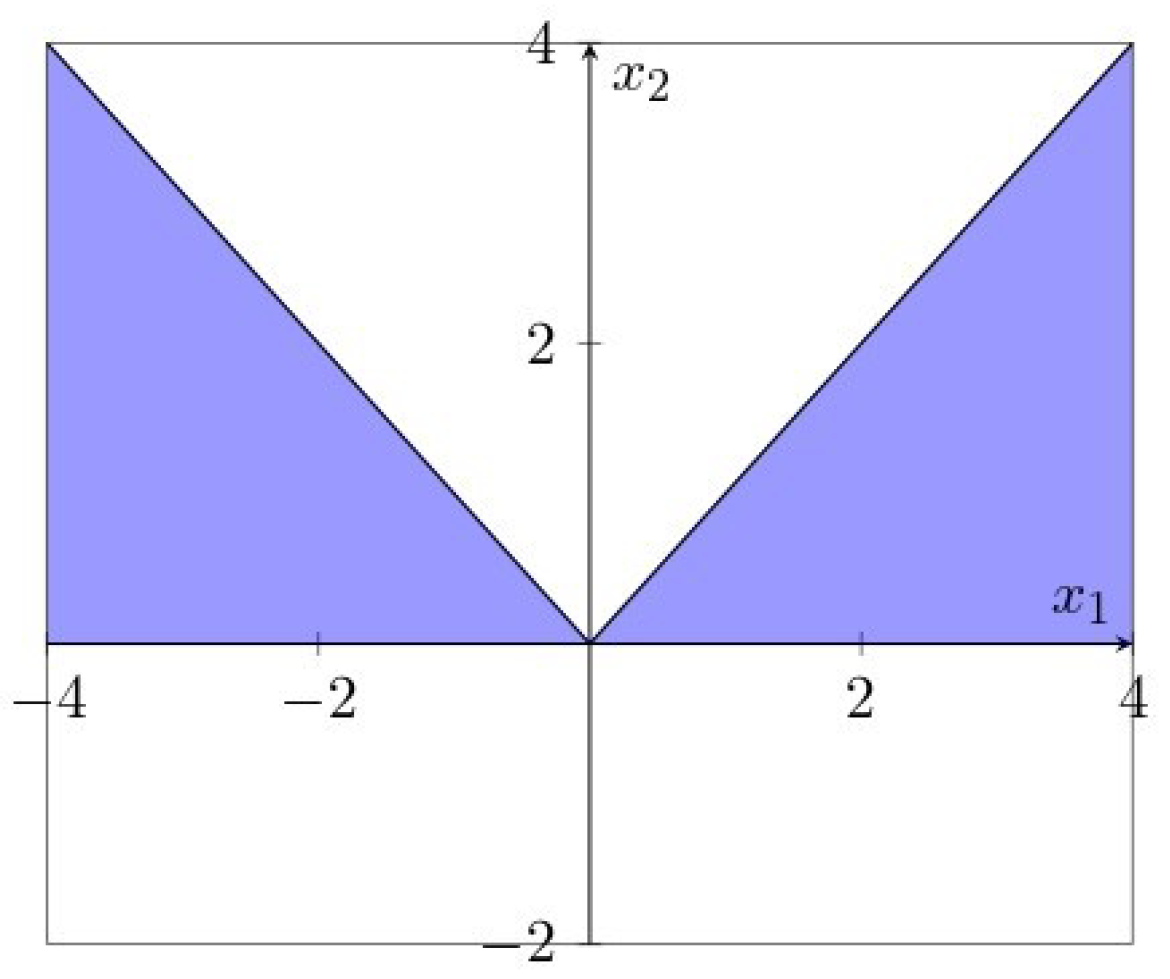Optimality Conditions for Mathematical Programs with Vanishing Constraints Using Directional Convexificators
Abstract
:1. Introduction
2. Preliminaries
- (a)
- A directional upper convexificator at ζ iff such that the set () is closed, and for each one has
- (b)
- A directional lower convexificator at ζ iff such that the set () is closed, and for each one has
- (c)
- A directional convexificator at ζ iff it is both an upper and lower directional convexificator of h at
- (d)
- An upper regular directional convexificator of h at ζ iff such that the set () is closed, and for each one has
- (e)
- A lower regular directional convexificator of h at ζ iff such the set is closed, and for each one has
3. Problem Formulation and Optimality Conditions
3.1. Problem Formulation
- (a)
- The generalized standard ACQ, denoted by —GS ACQ, is satisfied at iff
- (b)
- The generalized MPVC ACQ, denoted by —MPVC ACQ, is satisfied at iff
- (a)
- —generalized weak stationary point (GW-stationary point) iff there are vectors ( and ) such that the following conditions hold:
- (b)
- (c)
3.2. Necessary Optimality Conditions
- (A1)
- is closed and convex;
- (A2)
- is closed;
- (A3)
3.3. Sufficient Optimality Condition
4. Duality
5. Conclusions
Author Contributions
Funding
Data Availability Statement
Acknowledgments
Conflicts of Interest
References
- Achtziger, W.; Kanzow, C. Mathematical programs with vanishing constraints: Optimality conditions and constraint qualifications. Math. Program. 2008, 114, 69–99. [Google Scholar] [CrossRef]
- Kirches, C.; Potschka, A.; Bock, H.G.; Sager, S. A Parametric Active Set Method for Quadratic Programs with Vanishing Constraints. Technical Report. 2012. Available online: https://mathopt.de/PUBLICATIONS/Kirches2011.pdf (accessed on 1 June 2024).
- Jabr, R.A. Solution to economic dispatching with disjoint feasible regions via semidefinite programming. IEEE Trans. Power Syst. 2011, 27, 572–573. [Google Scholar] [CrossRef]
- Jung, M.N.; Kirches, C.; Sager, S. On perspective functions and vanishing constraints in mixed-integer nonlinear optimal control. In Facets of Combinatorial Optimization: Festschrift for Martin Grötschel; Jünger, M., Reinelt, G., Eds.; Publishing House: Berlin/Heidelberg, Germany, 2013; pp. 387–417. [Google Scholar]
- Palagachev, K.; Gerdts, M. Mathematical programs with blocks of vanishing constraints arising in discretized mixed-integer optimal control problems. Set-Valued Var. Anal. 2015, 23, 149–167. [Google Scholar] [CrossRef]
- Luo, Z.Q.; Pang, J.S.; Ralph, D. Mathematical Programs with Equilibrium Constraints; Cambridge University Press: Cambridge, UK, 1996. [Google Scholar]
- Outrata, J.; Kocvara, M.; Zowe, J. Nonsmooth Approach to Optimization Problems with Equilibrium Constraints: Theory, Applications and Numerical Results; Springer Science & Business Media: Dordrecht, The Netherlands, 2013. [Google Scholar]
- Laha, V.; Singh, H.N. On quasidifferentiable mathematical programs with equilibrium constraints. Comput. Manag. Sci. 2023, 20, 30. [Google Scholar] [CrossRef]
- Hoheisel, T.; Kanzow, C. First-and second-order optimality conditions for mathematical programs with vanishing constraints. Appl. Math. 2007, 52, 495–514. [Google Scholar] [CrossRef]
- Hoheisel, T.; Kanzow, C. On the Abadie and Guignard constraint qualifications for mathematical programmes with vanishing constraints. Optimization 2009, 58, 431–448. [Google Scholar] [CrossRef]
- Hoheisel, T.; Kanzow, C.; Outrata, J.V. Exact penalty results for mathematical programs with vanishing constraints. Nonlinear Anal. Theory Methods Appl. 2010, 72, 2514–2526. [Google Scholar] [CrossRef]
- Mishra, S.K.; Singh, V.; Laha, V. On duality for mathematical programs with vanishing constraints. Ann. Oper. Res. 2016, 243, 249–272. [Google Scholar] [CrossRef]
- Mishra, S.K.; Singh, V.; Laha, V.; Mohapatra, R.N. On constraint qualifications for multiobjective optimization problems with vanishing constraints. In Optimization Methods, Theory and Applications; Springer: Berlin/Heidelberg, Germany, 2015; pp. 95–135. [Google Scholar]
- Hoheisel, T. Mathematical Programs with Vanishing Constraints; Universität Würzburg: Würzburg, Germany, 2009. [Google Scholar]
- Laha, V.; Kumar, R.; Singh, H.N.; Mishra, S.K. On minimax programming with vanishing constraints. In Optimization, Variational Analysis and Applications: IFSOVAA-2020, Varanasi, India, February 2–4; Springer: Singapore, 2021; pp. 247–263. [Google Scholar]
- Hu, Q.; Zhou, Z.; Chen, Y. Some convexificators-based optimality conditions for nonsmooth mathematical program with vanishing constraints. Am. J. Oper. Res. 2021, 11, 324–337. [Google Scholar] [CrossRef]
- Van Su, T.; Hang, D.D. Optimality conditions and duality theorems for nonsmooth semi-infinite interval-valued mathematical programs with vanishing constraints. Comput. Appl. Math. 2022, 41, 422. [Google Scholar] [CrossRef]
- Sadeghieh, A.; Kanzi, N.; Caristi, G. On stationarity for nonsmooth multiobjective problems with vanishing constraints. J. Glob. Optim. 2022, 82, 929–949. [Google Scholar] [CrossRef]
- Demyanov, V. Convexification and concavification of positively homogeneous functions by the same family of linear functions. Report 1994, 3, 802. [Google Scholar]
- Jeyakumar, V.; Luc, D.T. Nonsmooth calculus, minimality, and monotonicity of convexificators. J. Optim. Theory Appl. 1999, 101, 599–621. [Google Scholar] [CrossRef]
- Golestani, M.; Nobakhtian, S. Convexificators and strong Kuhn–Tucker conditions. Comput. Math. Appl. 2012, 64, 550–557. [Google Scholar] [CrossRef]
- Laha, V.; Dwivedi, A. On approximate strong KKT points of nonsmooth interval-valued mutiobjective optimization problems using convexificators. J. Anal. 2024, 32, 219–242. [Google Scholar] [CrossRef]
- Laha, V.; Mishra, S.K. On vector optimization problems and vector variational inequalities using convexificators. Optimization 2017, 66, 1837–1850. [Google Scholar] [CrossRef]
- Pandey, Y.; Mishra, S.K. Duality for nonsmooth optimization problems with equilibrium constraints, using convexificators. J. Optim. Theory Appl. 2016, 171, 694–707. [Google Scholar] [CrossRef]
- Jaisawal, P.; Laha, V. On sufficiency and duality for multiobjective programming problems using convexificators. Filomat 2022, 36, 3119–3139. [Google Scholar] [CrossRef]
- Pany, G.; Mohapatra, R.N. A study on vector variational-like inequalities using convexificators and application to its bi-level form. J. Ind. Manag. Optim. 2022, 6, 4333–4350. [Google Scholar] [CrossRef]
- Mishra, S.K.; Kumar, R.; Laha, V.; Maurya, J.K. Optimality and duality for semidefinite multiobjective programming programs using convexificators. J. Appl. Numer. Optim. 2022, 4, 103–118. [Google Scholar]
- Upadhyay, B.B.; Mishra, P.; Mohapatra, R.N.; Mishra, S.K. On the applications of nonsmooth vector optimization problems to solve generalized vector variational inequalities using convexificators. In World Congress on Global Optimization; Springer International Publishing: Cham, Switzerland, 2019; pp. 660–671. [Google Scholar]
- Dempe, S.; Pilecka, M. Necessary optimality conditions for optimistic bilevel programming problems using set-valued programming. J. Glob. Optim. 2015, 61, 769–788. [Google Scholar] [CrossRef]
- Gadhi, N.A.; Rahou, F.Z.; El Idrissi, M.; Lafhim, L. Optimality conditions of a set valued optimization problem with the help of directional convexificators. Optimization 2021, 70, 575–590. [Google Scholar] [CrossRef]
- Gadhi, N.A. On variational inequalities using directional convexificators. Optimization 2021, 71, 2891–2905. [Google Scholar] [CrossRef]
- Lafhim, L.; Kalmoun, E.M. Optimality conditions for mathematical programs with equilibrium constraints using directional convexificators. Optimization 2023, 72, 1363–1383. [Google Scholar] [CrossRef]
- El Idrissi, M.; Gadhi, N.A.; Ohda, M. Applying directional upper semi-regular convexificators in bilevel optimization. Optimization 2022, 72, 3045–3062. [Google Scholar] [CrossRef]
- Gadhi, N.A.; Ohda, M. Optimality conditions for MPECs in terms of directional upper convexifactors. RAIRO-Oper. Res. 2022, 56, 4303–4316. [Google Scholar] [CrossRef]
- Wolfe, P. A duality theorem for nonlinear programming. Q. J. Appl Math. 1961, 19, 239–244. [Google Scholar] [CrossRef]
- Fallahi, K.; Ghobadzadeh, M. Wolfe type duality for nonsmooth optimization problems with vanishing constraints. J. Math. Ext. 2021, 16, 1. [Google Scholar]
- Joshi, B.C. Mathematical programs with vanishing constraints involving strongly invex functions. Numer. Algorithms 2022, 91, 505–530. [Google Scholar] [CrossRef]
- Guo, L.; Lin, G.H.; Zhao, J. Wolfe-type duality for mathematical programs with equilibrium constraints. Acta Math. Appl. Sin. Engl. Ser. 2019, 35, 532–540. [Google Scholar] [CrossRef]
- Pandey, Y.; Mishra, S.K. Optimality conditions and duality for semi-infinite mathematical programming problems with equilibrium constraints, using convexificators. Ann. Oper. Res. 2018, 269, 549–564. [Google Scholar] [CrossRef]
- Mishra, S.K.; Jaiswal, M.; An, L.T.H. Duality for nonsmooth semi-infinite programming problems. Optim. Lett. 2021, 6, 261–271. [Google Scholar] [CrossRef]
- Tung, L.T. Karush-Kuhn-Tucker optimality conditions and duality for multiobjective semi-infinite programming via tangential subdifferentials. Numer. Funct. Anal. Optim. 2020, 41, 659–684. [Google Scholar] [CrossRef]
- Wu, H.C. Duality theory for optimization problems with interval-valued objective functions. J. Optim. Theory Appl. 2010, 144, 615–628. [Google Scholar] [CrossRef]
- Singh, D.; Dar, B.A.; Kim, D.S. Sufficiency and duality in non-smooth interval valued programming problems. J. Ind. Manag. Optim. 2019, 15, 647–665. [Google Scholar] [CrossRef]
- Van Su, T.; Dinh, D.H. Duality results for interval-valued pseudoconvex optimization problem with equilibrium constraints with applications. Comput. Appl. Math. 2020, 39, 127. [Google Scholar] [CrossRef]
- Jayswal, A.; Stancu-Minasian, I.; Banerjee, J. Optimality conditions and duality for interval-valued optimization problems using convexifactors. Rend. Circ. Mat. Palermo 2016, 65, 17–32. [Google Scholar] [CrossRef]
- Van Luu, D.; Mai, T.T. Optimality and duality in constrained interval-valued optimization. 4OR 2018, 16, 311–337. [Google Scholar] [CrossRef]
- Lai, K.K.; Mishra, S.K.; Hassan, M.; Bisht, J.; Maurya, J.K. Duality results for interval-valued semiinfinite optimization problems with equilibrium constraints using convexificators. J. Inequal. Appl. 2022, 2022, 128. [Google Scholar] [CrossRef]
- Van Su, T.; Hang, D.D.; Dieu, N.C. Optimality conditions and duality in terms of convexificators for multiobjective bilevel programming problem with equilibrium constraints. Comput. Appl. Math. 2021, 40, 37. [Google Scholar] [CrossRef]
- Schirotzek, W. Nonsmooth Analysis; Springer Science & Business Media: Berlin/Heidelberg, Germany, 2007. [Google Scholar]
- Bazaraa, M.S.; Sherali, H.D.; Shetty, C.M. Nonlinear Programming: Theory and Algorithms; John Wiley & Sons: Hoboken, NJ, USA, 2013. [Google Scholar]
- Kabgani, A.; Soleimani-Damaneh, M. Constraint qualifications and optimality conditions in nonsmooth locally star-shaped optimization using convexificators. Pac. J. Optim. 2019, 15, 399–413. [Google Scholar]




Disclaimer/Publisher’s Note: The statements, opinions and data contained in all publications are solely those of the individual author(s) and contributor(s) and not of MDPI and/or the editor(s). MDPI and/or the editor(s) disclaim responsibility for any injury to people or property resulting from any ideas, methods, instructions or products referred to in the content. |
© 2024 by the authors. Licensee MDPI, Basel, Switzerland. This article is an open access article distributed under the terms and conditions of the Creative Commons Attribution (CC BY) license (https://creativecommons.org/licenses/by/4.0/).
Share and Cite
Mohapatra, R.N.; Sachan, P.; Laha, V. Optimality Conditions for Mathematical Programs with Vanishing Constraints Using Directional Convexificators. Axioms 2024, 13, 516. https://doi.org/10.3390/axioms13080516
Mohapatra RN, Sachan P, Laha V. Optimality Conditions for Mathematical Programs with Vanishing Constraints Using Directional Convexificators. Axioms. 2024; 13(8):516. https://doi.org/10.3390/axioms13080516
Chicago/Turabian StyleMohapatra, Ram Narayan, Prachi Sachan, and Vivek Laha. 2024. "Optimality Conditions for Mathematical Programs with Vanishing Constraints Using Directional Convexificators" Axioms 13, no. 8: 516. https://doi.org/10.3390/axioms13080516






